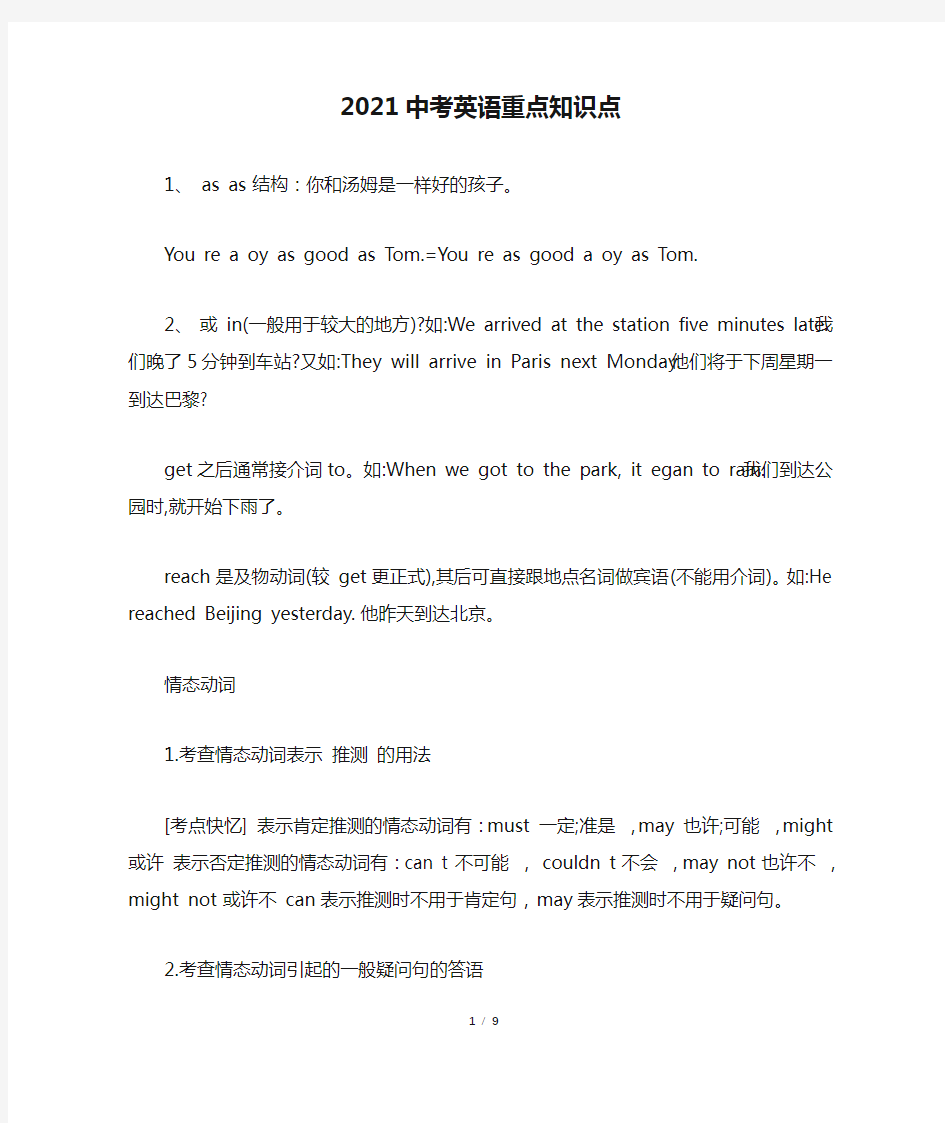2021中考英语重点知识点


2021中考英语重点知识点
1、 as as 结构:你和汤姆是一样好的孩子。
You re a oy as good as Tom.=You re as good a oy as Tom.
2、或 in(一般用于较大的地方)?如:We arrived at the station five minutes late. 我们晚了5分钟到车站?又如:They will arrive in Paris next Monday. 他们将于下周星期一到达巴黎?
get之后通常接介词to。如:When we got to the park, it egan to rain. 我们到达公园时,就开始下雨了。
reach是及物动词(较 get更正式),其后可直接跟地点名词做宾语(不能用介词)。如:He reached Beijing yesterday. 他昨天到达北京。
情态动词
1.考查情态动词表示推测的用法
[考点快忆] 表示肯定推测的情态动词有:must 一定;准是,may 也许;可能,might 或许表示否定推测的情态动词有:can t 不可能, couldn t 不会,may not 也许不,might not 或许不 can表示推测时不用于肯定句,may 表示推测时不用于疑问句。
2.考查情态动词引起的一般疑问句的答语
[考点快忆] 回答must时,肯定答语用must,否定答语用needn t或don t have to。回答need时,肯定答语用must,否定答语用needn t。回答may时,肯定答语用may,否定答语用mustn t 或can t。
3.考查情态动词的意义
[考点快忆] must 必须 have to 不得不 need 必须;需要 can(could) 能;可能 may (might) 可以;可能 shall,will (would) 将;会;愿意;要 should 应当。
had etter (not) + 动词原形表示建议;have to / has to / had to的否定,疑问形式要借助于助动词do / does / did。
There e 的句子结构
There e是一个存在句型,表示有的意思,
肯定句的形式为:There e + 名词(单数或复数)+地点状语或时间状语。
e动词单复数的确定,看e后边第一个名词,当所接主语为单数或不可数名词时,e动词形式为is;当所接主语为复数名词时,e动词为are;当e动词后接两个以上主语时,e动词与最临近主语保持数上的一致。意思为某地有某人或某物。如:
There is an eraser and two pens on the desk. 桌子上有一块橡皮和两支钢笔。
There are two pens and an eraser on the desk. 桌上有两支钢笔和一块橡皮。
(1)there e的否定句,即在e的后面加上not。
否定形式为:There e + not + (any) + 名词+地点状语。
There is not any cat in the room. 房间里没猫。
There aren t any ooks on the desk. 桌子上没书。
(2)there e句型的疑问句就是将e提到句首:Be there + (any) +名词+地点状语
肯定回答:Yes, there is / are. 否定回答:No, there isn t / aren t.
-Is there a dog in the picture?画上有一只狗吗
-Yes, there is. 有。
-Are there any oats in the river?河里有船吗
-No, there aren t. 没有。
(3)特殊疑问句:How many . . . are there (+地点状语)
某地有多少人或物回答用There e . . .
There s one. / There are two / three / some . . .
有时直接就用数字来回答。One. / Two . . .
-How many students are there in the classroom?教室里有多少学生
-There s only one. / There are nine. 只有一个。/有九个。
(4)如果名词是不可数名词,用:How much + 不可数名词 + is there + 地点状语
How much water is there in the cup?杯中有多少水
中考对定语从句的考查:
1.定语从句的功用和结构
在复合句中,修饰某一名词或代词的从句叫做定语从句。被定从句修饰的词叫做先行词。定语从句必须放在先行词之后。引导定语从句的关联词有关系代词和关系副词。例如:
This is the present that he gave me for my irthday
2.关系代词和关系副词的功用
关系代词和关系副词用来引导定于从句,在先行词和定语从句之间起纽带作用,使二者联系起来。关系代词和关系副词又在定语从句中充当一个成分。关系待客做主语,宾语,定语,关系副词可作状语。
1. 作主语:关系代词在定语从句中作主语时,从句的谓语动词的人称和数须和先行词一致。例如:
I don t like people who talk much ut do little.
The cars which are produced in Huei Province sell very well.
2. 作宾语:She is the person that I met at the school gate yesterday. The ook that my grandmother gave me is called The Great Escape .
3. 作定语
关系代词whose在定语从句中作定语用。例如:
What s the name of the young man whose sister is a doctor?
The girl whose father is a teacher studies very hard.
4. 作状语
I ll never forget the day when I first came to Beijing.
三. 各个关系代词和关系副词的具体用法
1. who 指人,在定语从句中作主语。例如:
The person who roke the window must pay for it.
The oy who is wearing the lack jacket is very clever. 2. whom指人,在定语从句中作宾语。例如:
Do you know the young man (whom) we met at the gate?
Mr Lee (whom) you want to see has come.
3. whose 指人,在定语从句中作定语。例如:
The girl whose mother is ill is staying at home today.
I know the oy whose father is a professor.
4. which指物,在定语从中作主语或宾语。例如:
A dictionary is a ook which gives the meaning of words.
Here is the ook (which) the teacher mentioned yesterday.
5. that多指物,有时也指人,在定语从句中作主语或宾语。例如:
I ve read the newspaper that(which) carries the important news. Who is the person that is reading the newspaper over there?
6. when 指时间,在定语从句中作状语。例如:
I ll never forget the time when we worked on the farm.
He arrived in Beijing on the day when I left.
7. where 指地点,在定语从句中作状语。例如:
This is the house where we lived last year.
The factory where his father works is in the east of the city.
四. 关系代词 whom, which 在定语从句中作介词宾语时,可以和介词一起放于先行词与定语从句之间,有时为了关系紧凑也可以将 whom 与 which 与先行词紧挨着书写,而将介词置于定语从句的后面,如:
That was the room in which we had lived for ten years. = That was the room
which we had lived in for ten years.
五. 具体使用时还要注意下列问题:
1. 只能使用that,不用which 的情况:
(1) 先行词是all, few, little, nothing, everything, anything 等不定代词时。例如:
All that he said is true.
(2) 先行词被only, no, any, all,等词修饰时。例如:
He is the only foreigner that has een to that place.
(3) 先行词是序数词或被序数词修饰的词。例如:
He was the second (person) that told me the secret.
(4) 先行词是形容词最高级或被形容词最高级修饰的词。
This is the est ook (that) I have read this year.
(5) 先行词既包括人又包括物时。例如:
He talked aout the people and the things he rememered.
2. 只能用which,不用that 的情况:
(1) 在非限制性定语从中。例如:
The meeting was put off, which was exactly what we wanted.
(2) 定语从句由介词+关系代词引导,先行词是物时。例如:
The thing aout which he is talking is of great importance.
考查的主要形式是单项填空、完型填空、短文填空和完成句子。阅读理解和书面表达肯定也要用到定语从句。
